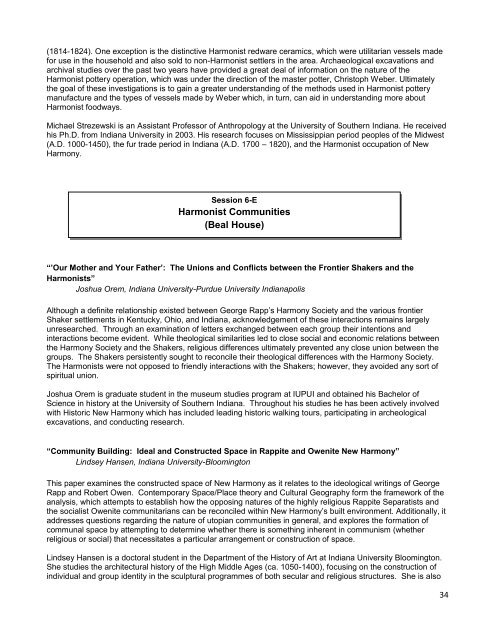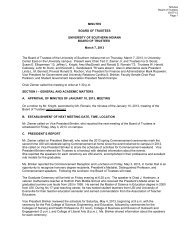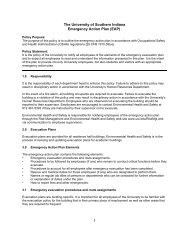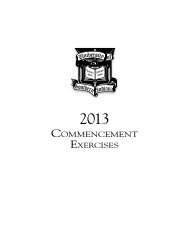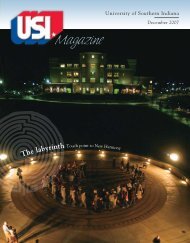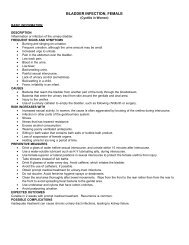Communal Studies Association, 2010 New Harmony, Indiana ...
Communal Studies Association, 2010 New Harmony, Indiana ...
Communal Studies Association, 2010 New Harmony, Indiana ...
You also want an ePaper? Increase the reach of your titles
YUMPU automatically turns print PDFs into web optimized ePapers that Google loves.
(1814-1824). One exception is the distinctive Harmonist redware ceramics, which were utilitarian vessels madefor use in the household and also sold to non-Harmonist settlers in the area. Archaeological excavations andarchival studies over the past two years have provided a great deal of information on the nature of theHarmonist pottery operation, which was under the direction of the master potter, Christoph Weber. Ultimatelythe goal of these investigations is to gain a greater understanding of the methods used in Harmonist potterymanufacture and the types of vessels made by Weber which, in turn, can aid in understanding more aboutHarmonist foodways.Michael Strezewski is an Assistant Professor of Anthropology at the University of Southern <strong>Indiana</strong>. He receivedhis Ph.D. from <strong>Indiana</strong> University in 2003. His research focuses on Mississippian period peoples of the Midwest(A.D. 1000-1450), the fur trade period in <strong>Indiana</strong> (A.D. 1700 – 1820), and the Harmonist occupation of <strong>New</strong><strong>Harmony</strong>.Session 6-EHarmonist Communities(Beal House)“‟Our Mother and Your Father‟: The Unions and Conflicts between the Frontier Shakers and theHarmonists”Joshua Orem, <strong>Indiana</strong> University-Purdue University <strong>Indiana</strong>polisAlthough a definite relationship existed between George Rapp‘s <strong>Harmony</strong> Society and the various frontierShaker settlements in Kentucky, Ohio, and <strong>Indiana</strong>, acknowledgement of these interactions remains largelyunresearched. Through an examination of letters exchanged between each group their intentions andinteractions become evident. While theological similarities led to close social and economic relations betweenthe <strong>Harmony</strong> Society and the Shakers, religious differences ultimately prevented any close union between thegroups. The Shakers persistently sought to reconcile their theological differences with the <strong>Harmony</strong> Society.The Harmonists were not opposed to friendly interactions with the Shakers; however, they avoided any sort ofspiritual union.Joshua Orem is graduate student in the museum studies program at IUPUI and obtained his Bachelor ofScience in history at the University of Southern <strong>Indiana</strong>. Throughout his studies he has been actively involvedwith Historic <strong>New</strong> <strong>Harmony</strong> which has included leading historic walking tours, participating in archeologicalexcavations, and conducting research.“Community Building: Ideal and Constructed Space in Rappite and Owenite <strong>New</strong> <strong>Harmony</strong>”Lindsey Hansen, <strong>Indiana</strong> University-BloomingtonThis paper examines the constructed space of <strong>New</strong> <strong>Harmony</strong> as it relates to the ideological writings of GeorgeRapp and Robert Owen. Contemporary Space/Place theory and Cultural Geography form the framework of theanalysis, which attempts to establish how the opposing natures of the highly religious Rappite Separatists andthe socialist Owenite communitarians can be reconciled within <strong>New</strong> <strong>Harmony</strong>‘s built environment. Additionally, itaddresses questions regarding the nature of utopian communities in general, and explores the formation ofcommunal space by attempting to determine whether there is something inherent in communism (whetherreligious or social) that necessitates a particular arrangement or construction of space.Lindsey Hansen is a doctoral student in the Department of the History of Art at <strong>Indiana</strong> University Bloomington.She studies the architectural history of the High Middle Ages (ca. 1050-1400), focusing on the construction ofindividual and group identity in the sculptural programmes of both secular and religious structures. She is also34


